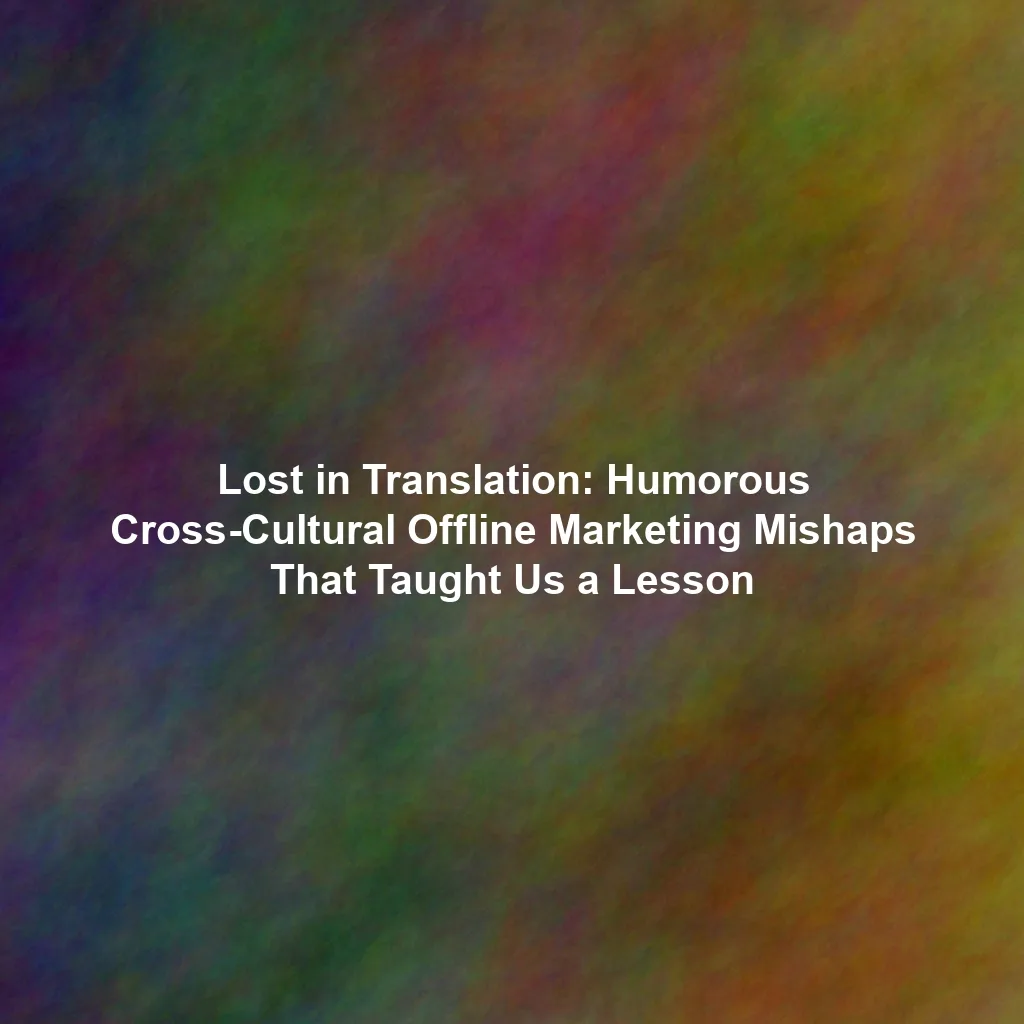When Words Fail: Translation Triumphs and Tragedies
The most frequent, and often most amusing, culprit behind these cross-cultural marketing mishaps is direct translation gone awry. It’s a scenario where a brand invests heavily in crafting a brilliant, catchy slogan or product name in its native language, only to discover, post-launch, that its literal translation means something entirely different—and frequently unintentionally hilarious, offensive, or just plain nonsensical—in another language. This isn’t just about grammar; it’s about idiom, slang, and cultural context.
KFC’s Finger Lickin’ Good… Turns Cannibalistic?
One of the most famous, almost legendary, examples of a translation blunder involves KFC’s iconic slogan, “Finger Lickin’ Good.” When the fast-food giant launched its first restaurants in China in the late 1980s, the slogan was translated, quite literally, as “Eat Your Fingers Off.” Suddenly, Colonel Sanders’ friendly, inviting face became a lot less appetizing and considerably more menacing. While the exact historical veracity of this specific translation might have been slightly embellished over the years through urban legend, the core truth remains undeniably potent: literal, word-for-word translations rarely work in marketing. This incident served as a stark, early reminder that a little “transcreation”—the process of adapting a message to fit the cultural context, tone, and nuances of the target market, rather than merely translating words—goes an incredibly long way in preventing such cannibalistic connotations.
Strategic Insight: The Power of Transcreation
Transcreation isn’t just translation; it’s cultural adaptation. It involves re-imagining the message to evoke the same emotions and carry the same implications in the target language as it does in the source language. This often means changing words, phrases, or even entire concepts to ensure cultural resonance. Brands like Coca-Cola have mastered this, with slogans that adapt globally while retaining core brand identity. For further reading on transcreation, explore resources from the American Translators Association (ATA).
Coors Light’s… Upsetting Digestive System?
Coors Light, a brand synonymous with crisp refreshment and mountain-fresh purity, aimed for a dynamic and liberating slogan: “Turn It Loose.” A seemingly innocuous phrase in English, implying freedom and relaxation. However, when this slogan was introduced into Spanish-speaking markets, its literal translation roughly equated to “Suffer From Diarrhea.” Imagine the marketing team’s horror! Nothing says refreshment and a good time quite like associating your product with… well, a rather unfortunate and urgent digestive issue. This served as a potent, albeit embarrassing, reminder that even common, idiomatic phrases in one language can have drastically different, and often highly undesirable, connotations across cultures. It underscores the peril of assuming direct linguistic equivalence.
Parker Pen’s Embarrassing Inking
The Parker Pen Company, a venerable brand known for quality writing instruments, sought to emphasize a key product benefit: their pens wouldn’t leak. Their chosen slogan in English was a reassuring “It won’t leak in your pocket and embarrass you.” A straightforward, practical promise. However, when this was translated into Spanish for a Latin American campaign, the message took an unexpected, and frankly bizarre, turn. It became “It won’t leak in your pocket and make you pregnant.” A slightly, or rather significantly, different selling point, to say the least! This blunder vividly highlights the critical importance of understanding not just the literal meaning of words, but also the nuances of language, the potential for double meanings, and the cultural context in which phrases are interpreted. It’s a classic example of how a simple linguistic oversight can lead to a truly memorable, and mortifying, marketing gaffe.
Anecdote: The Unintended “Gift”
A global tech company, launching a new software product in Japan, decided to name it “Nova.” They thought it sounded modern and innovative. What they failed to realize was that “No-va” (ノバ) in Japanese, when pronounced similarly, could sound like “no-ba” (野場), which can mean “field” or “wilderness,” but in certain contexts, colloquially refers to a “brothel.” A Japanese marketing consultant recounted the initial confusion and quiet amusement among local teams. “It wasn’t offensive, just… very, very odd for software,” she explained. The company quickly rebranded the product for the Japanese market, learning that even seemingly universal names require local linguistic vetting.
Beyond Words: Cultural Sensitivity Faux Pas
Sometimes, the language used in a marketing campaign is technically correct, grammatically sound, and free of direct translation errors. Yet, the message still completely misses the mark, or worse, causes offense, due to a profound lack of understanding of local customs, deeply held beliefs, societal values, or historical context. These are the blunders that highlight the need for cultural immersion, not just linguistic proficiency.
Pepsi’s Planetary Problems: Bringing Back the Dead?
Pepsi once launched a major global campaign with the seemingly positive and life-affirming slogan, “Pepsi Brings You Back to Life.” In Western cultures, this implies refreshment, invigoration, and a burst of energy. However, this innocuous phrase backfired spectacularly in certain Asian countries, particularly in regions with strong traditions of ancestor veneration. In these cultures, the phrase “bringing back to life” is almost exclusively used in connection with the spiritual realm, implying the resurrection of the dead. The notion that a carbonated soft drink could perform such a feat was not only absurd but deeply disrespectful and even sacrilegious to many. It resulted in a significant public relations disaster, demonstrating the critical need to research and understand cultural beliefs surrounding profound concepts like life, death, and spirituality before launching a global campaign. For more on the importance of cultural context in marketing, see this Harvard Business Review article.
Gerber’s Jarring Revelation: What’s Inside the Jar?
Gerber, the renowned baby food company, famously uses a picture of a cute, smiling baby on its product packaging in the United States. This is a universally understood visual cue for baby food in many Western markets. When Gerber attempted to introduce its products to certain African countries, they encountered a fundamental cultural difference that led to significant confusion and potentially damaged sales. In many African nations, particularly in areas with lower literacy rates, companies traditionally put pictures of what’s *inside* the package on the label, precisely because many consumers couldn’t read the ingredients list. So, when local consumers saw a picture of a baby on the Gerber jar, their logical (and quite disturbing) conclusion was that the product contained… baby. While the intent was undeniably good and the packaging was effective elsewhere, a simple oversight regarding local communication norms led to a jarring and counterproductive revelation. This highlights the importance of ethnographic research and local market testing.
The Green Light for Trouble: Color Symbolism
Colors carry immense symbolic weight that varies dramatically across cultures. For example, green is often associated with nature, growth, and freshness in many Western countries. However, in some South American nations, green can be associated with death or danger. In parts of the Middle East, it’s strongly linked to Islam and can be seen as inappropriate for secular products. A brand attempting to launch a new “eco-friendly” product line using a predominantly green palette might inadvertently send a completely different, and negative, message in certain markets. This demonstrates that even seemingly universal design elements require rigorous cultural vetting.
Tone-Deaf Messaging: When Good Intentions Go Awry
Even with accurate translations and a general awareness of cultural differences, a brand can still stumble if the overall tone, context, or underlying message of a campaign feels inappropriate, insensitive, or simply out of touch for the target audience. This often comes down to a lack of empathy or a misjudgment of the local mood.
Unfortunate Timing and Imagery: Reading the Room
Imagine a lavish billboard campaign promoting high-end luxury goods—expensive cars, designer watches, opulent jewelry—placed prominently in a region that has just experienced a major economic downturn, a natural disaster, or significant social unrest. The message, even if perfectly translated and culturally relevant in isolation, would come across as profoundly insensitive, tone-deaf, and out of touch with the lived realities of the local population. The timing and context are everything. Such a campaign would not only fail to generate sales but could also severely damage the brand’s reputation and goodwill, leading to consumer backlash and accusations of corporate arrogance.
Similarly, imagery can be deeply misconstrued. Using images that promote outdated gender stereotypes, depict certain social classes in an unflattering light, or feature symbols that are considered offensive or taboo in a particular region can be incredibly damaging. For instance, a handshake gesture that is common in one culture might be an insult in another. A picture of a woman dressed in a way considered immodest in a conservative society, even if common in the brand’s home country, can lead to outrage and boycotts. These visual blunders underscore that communication is holistic; it’s not just about words but also about the visual language and the unspoken cultural rules that govern perception. For more on the role of context, see this Forbes article on marketing context.
Anecdote: The “Perfect” Family Photo
A European furniture retailer launched a print ad campaign in the Middle East featuring a “perfect family” enjoying their new living room. The photo showed a mother, father, and two children. However, the father was seated on the sofa with his legs crossed, revealing the sole of his shoe. In many Middle Eastern cultures, showing the sole of your shoe is considered a grave insult. The company received numerous complaints, and the campaign was quickly pulled. A seemingly innocent pose in one culture was a deeply disrespectful gesture in another, highlighting the nuances of non-verbal communication.
Visual Blunders and Symbolism: A Picture is Worth a Thousand Misinterpretations
Beyond words and general tone, visual elements themselves can be potent sources of miscommunication and offense. Colors, numbers, animals, and gestures all carry rich, often divergent, symbolic meanings across different cultures. A successful marketing campaign relies not just on what is said, but what is seen and implicitly understood.
Colors: The Silent Communicators
As mentioned, colors are powerful. White, for instance, is the color of purity and weddings in many Western cultures, but it’s the color of mourning and death in many Asian cultures. Black, often associated with sophistication or mourning in the West, can be seen as evil or unlucky elsewhere. A brand launching a new bridal line with a white theme in a market where white signifies funerals would face significant challenges. Similarly, red, a color of passion and danger in some cultures, is a symbol of good luck and prosperity in China. Misusing colors can lead to products being ignored, misunderstood, or even rejected outright.
Numbers and Animals: Superstition and Reverence
Numbers also hold cultural significance. The number four (四) in Chinese sounds similar to the word for death (死), making it highly unlucky. Conversely, eight (八) sounds like “wealth” (發) and is considered very auspicious. Marketing campaigns featuring four items or prices ending in four might inadvertently deter Chinese consumers. Animals, too, are imbued with meaning. An owl, a symbol of wisdom in the West, can be a harbinger of bad luck or death in some parts of the Middle East and Africa. Using a pig in marketing materials would be highly offensive in Muslim or Jewish cultures due to religious dietary laws.
Gestures: The Universal Language That Isn’t
What seems like a simple, friendly gesture in one country can be a profound insult in another. The “thumbs up” gesture, generally positive in many Western nations, is considered highly offensive in parts of the Middle East, West Africa, and South America, akin to giving someone “the finger.” The “OK” sign (thumb and forefinger forming a circle) is positive in the US but means “money” in Japan, “zero” or “worthless” in France, and is an obscene gesture in parts of Brazil and Germany. These non-verbal cues are often overlooked in localization efforts but can cause immediate and severe damage to a brand’s image.
The Digital Dimension: Offline Lessons for Online Engagement
While this article has focused on offline marketing blunders, it’s crucial to recognize that the lessons learned from these physical world gaffes are more relevant than ever in the digital age. The internet, with its instant global reach and rapid virality, amplifies both marketing successes and failures. A cultural misstep in a social media campaign can spread globally in minutes, leading to widespread condemnation and irreparable brand damage. The principles of thorough cultural research, professional transcreation, and local market testing are not just good practices for billboards and print ads; they are absolutely essential for any brand operating in the interconnected online world.
Lessons Learned: Avoiding the Marketing Minefield
So, what can astute marketers and global brands learn from these epic, often embarrassing, marketing fails? The key takeaways are not just cautionary tales but actionable strategies for effective global communication:
- Invest in Professional Translation and Localization, Not Just Translation: Never rely on free online translation tools or untrained, non-native speakers for critical marketing copy. Hire professional linguists who specialize in localization and transcreation. They understand not only the language but also the cultural nuances, idiomatic expressions, and local sensitivities. This investment is a fraction of the cost of a major PR crisis.
- Conduct Thorough Cultural Research: Before entering any new market, conduct deep ethnographic and cultural research. Understand local customs, religious beliefs, historical contexts, social values, humor, taboos, and non-verbal communication. This includes researching potentially offensive imagery, colors, numbers, and gestures. What is acceptable or even celebrated in one culture can be deeply offensive in another.
- Test Your Message with Local Audiences: Before launching any significant campaign, especially offline ones with high production costs, test your materials with a representative sample of your target audience within that specific market. Conduct focus groups, surveys, and informal feedback sessions. Get their honest, unfiltered feedback on the copy, imagery, and overall message. Make adjustments based on their insights.
- Consider Transcreation as a Standard Practice: Recognize that for marketing messages, a direct translation simply won’t cut it. Transcreation involves adapting the message to resonate emotionally and culturally with the target audience, while still maintaining the brand’s core values, tone, and desired impact. It’s about conveying the intent and emotion, not just the words.
- Be Flexible, Adaptable, and Ready to Respond: Marketing is an ongoing, dynamic process, especially on a global scale. Be prepared to adjust your strategy based on real-time feedback, market shifts, and unforeseen cultural reactions. Have a crisis communication plan in place for each market, and be ready to issue apologies, clarify messages, or pull campaigns quickly if a blunder occurs.
- Embrace Local Expertise: Partner with local marketing agencies, cultural consultants, and native speakers who possess intimate knowledge of the target market. Their insights are invaluable in navigating the subtle complexities that outsiders might miss.
Conclusion: A Global Laughingstock… and a Valuable Lesson
While these cross-cultural marketing mishaps might provide a good laugh (often at the considerable expense of some very embarrassed companies), they serve as potent, undeniable reminders of the paramount importance of meticulous localization and profound cultural sensitivity in global marketing. In an increasingly interconnected and digitally transparent world, understanding your audience—not just their demographics, but their deeply ingrained cultural fabric—is more crucial and complex than ever before. By making a strategic investment in rigorous research, engaging professional transcreation services, and cultivating a healthy, proactive dose of cultural awareness, brands can meticulously navigate the treacherous marketing minefield. The goal isn’t just to avoid becoming the next viral laughingstock; it’s to build a truly global brand that resonates authentically, fosters trust, and genuinely connects with people all over the world. So, go forth, market boldly, but always remember to meticulously check your translations – and perhaps triple-check them for any unexpected pregnancies or unintended insults. The ROI on cultural due diligence is immeasurable.
 Skip to content
Skip to content

